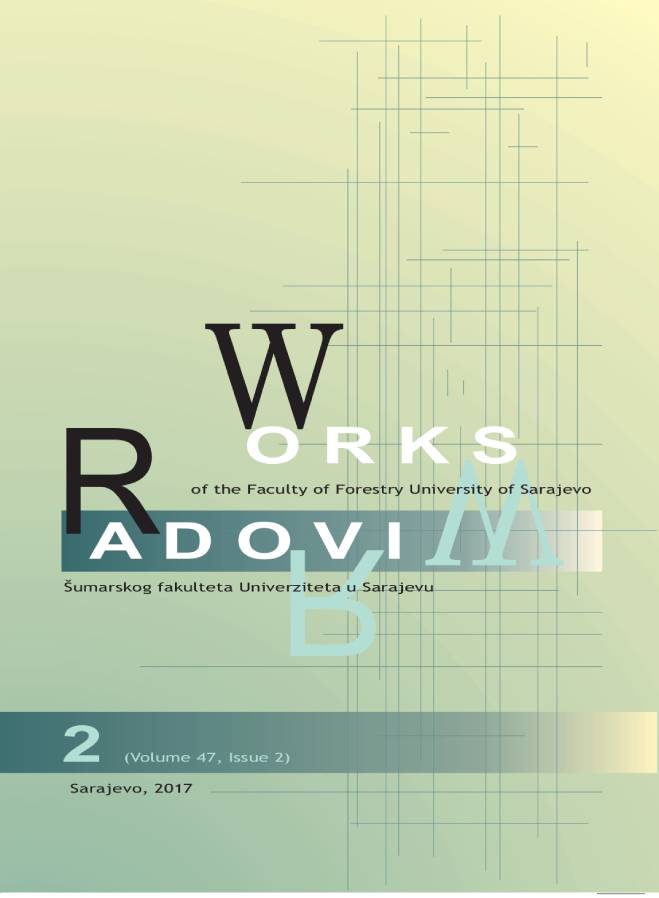SELECTION OF REGRESSION MODELS FOR GRAPHICALLY DETERMINED SITE CLASS CURVES FOR FIR IN UNEVEN-AGED STANDS IN BOSNIA AND HERCEGOVINA
DOI:
https://doi.org/10.54652/rsf.2017.v47.i2.59Keywords:
fir, site quality, height site class disposition, regression models, stand volumeAbstract
UDK: 630*54:582.475(497.6)
In expert activities of forest managements, the forest stand volume is most frequently determined by way of volume tables, the so-called management tariffs. For an evaluation of stand volume using this method, the method of volume tables, it is necessary to know the site class (rating) of the stand for present tree species that is used as an argument for the selection of suitable volume progression (management tariff). The site quality for certain species in mixed stands is determined by comparing the height of trees at certain diameters at breast height (dbh) with the height of appropriate dispositions of height site class curves. In so doing the focus is placed on the ratio between the heights of large diameter trees, and the quality of the stand is rated within an interval of more defined site quality classes. For the purposes of a more objective and simpler assessment of site quality, there have recently been attempts to make site quality assessments mathematically, using appropriate formulas in which tree heights or average heights by diameter classes and heights determined by mathematical functions of site class curves are used. For economically important tree species in Bosnia and Herzegovina (fir, spruce, beech, sessile oak, black pine and scots pine), the dispositions of height site class curves (and classes) are constructed graphically and mathematical functions for them are not known. A large number of mathematical models that are often used to represent growth trends and that satisfy the needs of height curves is analyzed in this paper with a view to determining the most suitable regression model for simulating height site class curves for fir in high forests in Bosnia and Herzegovina. The expanded Prodan model (with an additional item in the denominator) has been selected as the most suitable one on the basis of statistical indicators of the regression model quality.
References
KRAMER, H., AKÇA, A. (2008): Leitfaden zur Waldmesslehre. J.D.Sauerländer's Verlag.5. erweiterte Auflage. Frankfurt am Main.
AVDAGIĆ, A. (2013): Unapređenje plana uzorka za procjenu boniteta staništa na osnovu visina stabala u šumama bukve, jele sa smrčom na krečnjacima. Magistarski rad. Šumarski fakultet Univerzitet u Sarajevu. Str.1-103
BALIĆ, B. (2003): Bonitiranje jednodobnih zasada bijelog bora (Pinus sylvestris L.) na karbonatnim supstratima u Bosni. I Simpozij poljoprivrede, veterinarstva i šumarstva. Neum. Zbornik radova Šumarskog fakulteta u Sarajevu.
BALIĆ, B., LOJO, A., IBRAHIMSPAHIĆ, A. (2007): Utvrđivanje bonitetne dispozicije staništa izdanačkih šuma bukve na području Kantona Sarajevo. Radovi Šumarskog fakulteta u Sarajevu. Radovi Šumarskog fakulteta u Sarajevu. No.1, –str 67-79.
BALIĆ, B. (2011): Proizvodnost, strukturna izgrađenost i modeli rasta i prirasta izdanačkih šuma bukve na području Kantona Sarajevo”. Doktorska disertacija. Šumarski fakultet Univerziteta u Sarajevu. Str.1-203.
BANKOVIĆ, S., PANTIĆ, D. (2006): Dendrometrija. Šumarski fakultet Univerziteta u Beogradu. Str.1-256.
BAUR, F. (1894): Die Holzmesskunde, 4., Aufl., Wien.
DRINIĆ, P. (1963): Taksacione osnove za gazdovanje šumama crnog bora u Bosni. Radovi Šumarskog fakulteta i Instituta za šumarstvo, Sarajevo. Br 8. str. 147-228.
ČABARAVDIĆ, A. (2017): Biometrika u šumarstvu i hortikulturi. Knjiga. Šumarski Fakultet Sarajevo.
DRİNİĆ, P., MATİĆ,V., PAVLİĆ, J., PROLİĆ, N., STOJANOVİĆ, O., VUKMİROVİĆ, V., KOPRİVİCA, M. (1990): Tablice taksacionih elemenata visokih i izdanačkih šuma u Bosni i Hercegovini. Posebno izdanje. Šumarski fakultet. 327 S.
IBRAHİMSPAHİĆ, A. (2004): Regresione analize proizvodnih karakteristika jednodobnih nenjegovanih šumskih zasada crnog bora (Pinus nigra Arn.) na karbonatnim supstratima u Bosni. Magistarski rad, mnsc. Šumarski fakultet Univerziteta u Sarajevu.
IBRAHIMSPAHIĆ, A. (2013): Prirast i razvoj sastojina bukve, jele i smrče u GJ „Igman“, doktrorska disertacija, mnsc. Šumarski fakultet Univerziteta u Sarajevu.
KRAMER, H., AKÇA, A. (2008): Leitfaden zur Waldmesslehre. J.D.Sauerländer's Verlag.5. erweiterte Auflage. Frankfurt am Main.
MİLETİĆ, Ž.(1950): Osnovi uređivanja prebirne šume. Knjiga I. Beograd.
LOJO, A. (2011): Fortmiranje gazdinskih klasa unutar šuma bukve i jele i šuma bukve i jele sa smrčom na krečnjacima i dolomitima. Doktorska disretacija. Šumarski fakultet Univerziteta u Sarajevu.
MATİĆ, V. (1959): Taksacioni elementi prebornih šuma jele, smrče i bukve na području Bosne. Radovi Šumarskog Fakulteta i Instituta za šumarstvo i drvnu industriju u Sarajevu, br.4.
PRANJİĆ, A., LUKİĆ, N. (1997): Izmjera šuma. Šumarski Fakultet Sveučilišta u Zagrebu. Str.1-410.
STOJANOVIĆ, O. (1966): Taksacione osnove za gazdovanje šumama bijelog bora u Bosni. Radovi Šumarskog fakulteta i Instituta za šumarstvo u Sarajevu. X. sveska 8.
VUKMİROVİĆ, V. (1963): Prirast i drugi taksacioni elementi hrasta kitnjaka u Bosni. Radovi Šumarskog fakulteta i Instituta za šumarstvo Sarajevo, XVII. Br.8., str. 81-142.
FLURY, PH. (1933): Über die Wachstumsverhältnisse des Plenterwaldes. Mitteilungen der Schweizerischen Centralanstalt für das forstliche Versuchwessen, XVIII Band, Heft I.


















